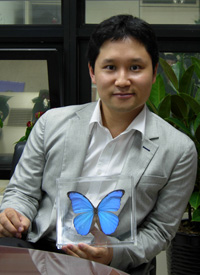 Professor KWON Sung-hoon's research team developed a high-resolution patterning technique that produces multiple sturctural colors within seconds by mimicking the structural colors found in butterfly wings and peacock feathers.
Professor KWON Sung-hoon's research team developed a high-resolution patterning technique that produces multiple sturctural colors within seconds by mimicking the structural colors found in butterfly wings and peacock feathers. Kwon said that he has overcome limitations in previous approaches to demonstrate rapid production of high-resolution patterns of multiple structural color and could develop?a simple, scalable way of producing structural color.
Structural colors, such as those on butterfly wings and peacock feathers, differ from traditional pigments or dyes in that the colour results from the interaction of light with periodic structures on the surface of the material.
These structural colors cannot be mimicked by chemical pigments or dyes and that they are free from photobleaching. What is more, multiple colours can be displayed using a single material simply by varying the dimension of the periodic nanostructures.
Such properties make structural color printing attractive for a range of applications, including forgery protection and the design of novel materials.
The attempts to manufacture artificial structural colour have proved time-consuming, requiring either the precise assembly of colloids of different sizes or the stacking and lithographic patterning of periodic dielectric materials.?
Kwon's team has found a way to produce a single ink of any desired color within a few seconds. The material, dubbed"M-Ink", changes colour when a magnetic field is applied. What's more, the colour can be rapidly locked into the material by shining patterned ultraviolet light onto its surface using maskless lithography.
In a similar way as the photonic bandgap in conventional photonic crystals diffracts different wavelengths of light, so too does the interparticle distance of the CNCs. A shorter interparticle distance corresponds to a shorter diffracted wavelength. Because the interparticle distance is determined by the applied magnetic field, the colour of the material can be altered simply by varying the magnetic field strength.
Once the desired colour is obtained from M-Ink, it can be fixed by solidifying the photocurable resin through ultraviolet exposure. The chain-like CNCs are then effectively frozen in the polymer network.
"As our photocuring is instantaneous, we can freeze the self-assembled photonic nanostructure fast enough to prevent distortion.?This means that we retain the structural colour."
Kwon has published this development on Nature Photonics.
September 30, 2009
SNU PR Office

